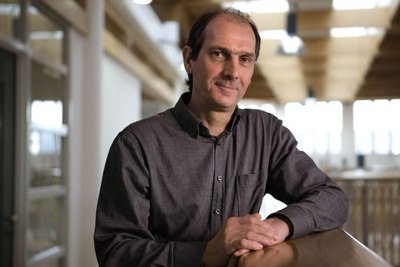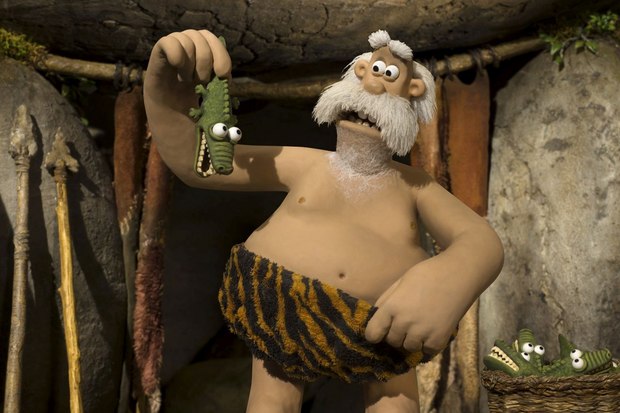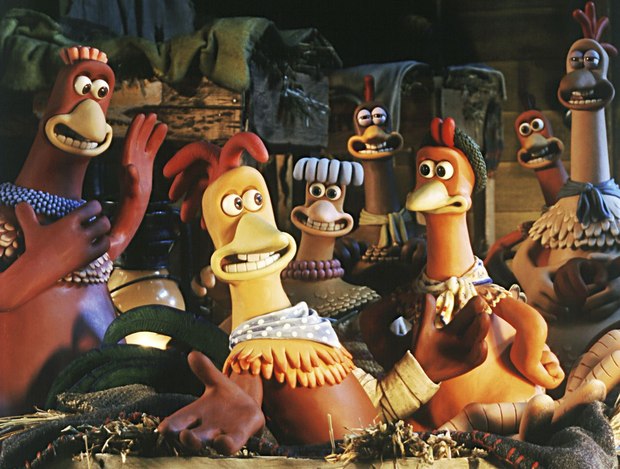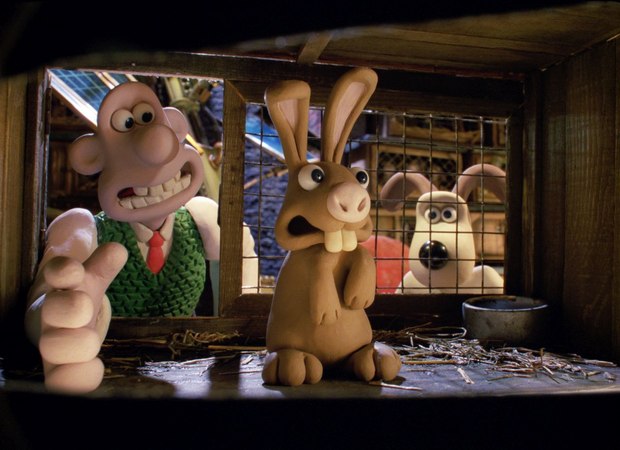As the venerable British studio releases its seventh feature film, co-founder Dave Sproxton begs the question of why his country lags behind in animated feature film production.
When it comes to animation, today’s audiences continue to smother big-studio CG films with lots of box office love. An ever-increasing number of these big-budget films invades theaters on a regular, some would say, too regular, basis. And while the quality and number of critically acclaimed independent animated features continues to grow as well, such as this year’s Oscar-nominated Loving Vincent and The Breadwinner, the “business” of theatrical animation continues to be dominated by just a few studios.
Now, consider stop-motion features. Over the last 25 years, besides the auteur-driven films of such directors as Tim Burton (Frankenweenie and The Corpse Bride), Henry Selick (James and the Giant Peach and The Nightmare Before Christmas), Wes Anderson (Fantastic Mr. Fox and the soon to be released Isle of Dogs) and Charlie Kaufman (Anomalisa) -- not forgetting Mark Osborne’s stop-motion / CG The Little Prince -- the main stop-motion films benefitting from a widespread theatrical release have come from the only two “studios” in the world that have continued to actively develop and produce primarily hand-made films features: Bristol’s Aardman Animations and Portland’s LAIKA.
David Sproxton, along with fellow co-founder Peter Lord, creative maestro Nick Park, and some of the most talented artists in the world, have managed to keep Aardman running for more than 40 years, entertaining audiences around the world in theatres, on TV and online, with a wide range of inventive, clever and funny stop-motion shows. Their award-winning list of films, TV, game and online work is as long as your arm, and includes the Oscar-winning animated shorts, Creature Comforts, The Wrong Trousers and A Close Shave, the Oscar-nominated shorts A Grand Day Out and A Matter of Loaf and Death, as well as the Oscar winning feature Wallace & Gromit: The Curse of the Were-Rabbit and Oscar-nominated Shaun the Sheep Movie and The Pirates! In an Adventure with Scientists!
However, when you consider U.K. feature animation production in any style or medium, you find Aardman pretty much stands alone. Their film Chicken Run, released in 2000, remains the international stop-motion box office champ at $227 million -- add the next two most successful, Wallace & Gromit: The Curse of the Were-Rabbit and The Pirates! In an Adventure with Scientists! (according to online movie data website The Numbers), and taken together, the trio represents over $560 million in global grosses. And while Aardman (along with LAIKA and others) continues to advance the art of stop-motion through integration of ever-increasingly sophisticated puppet-making, set design and 3D printing rapid prototyping technology, in addition to leveraging CG animation for everything from backgrounds and crowds to visual effects and complete digital characters, they still fight an uphill battle getting their features financed and distributed internationally. The numbers have never been kind to the stop-motion masters.
Which brings us to the upcoming release of Aardman’s latest stop-motion film, Early Man. Released last week in the U.K. and set to hit U.S. theatres February 16th, Early Man is the studio’s seventh feature film and second (after 2015’s Shaun the Sheep Movie) primarily financed by StudioCanal, a business unit of the French media giant Vivendi.
After releasing three films with DreamWorks Animations, followed by two with Sony Pictures Animation/Columbia, Aardman has shifted gears to partner with a film production company a bit closer to home, right across the English Channel. One possible reason for the shift might be necessity -- the top 10 highest grossing stop-motion films combined have generated less global box office than that of a single film, Disney’s Frozen, the highest grossing animated feature of all time at $1.29 billion, and the big U.S. studios have become increasingly risk averse in their animation production slate decision-making. Big money films require big-money pipelines from genesis to toy production. And audiences love their CG. Another possible reason is that in Europe especially -- with its history of government-supported animation production and international co-productions based on fiscal necessity -- financiers are willing to back smaller budget films that through subsidies, box office growth outside the U.S. and increasing revenue opportunities via digital distribution, can make enough money to sustain the industry.
Why is this relevant? Because more animated features are being released today than ever before, with large, well-funded studios like Disney (Disney Feature Animation and Pixar), NBCUniversal (Illumination and DreamWorks), Fox (Fox Animation Studios and BlueSky Studios) and Warner Bros. continuing to dominate the global box office. Everyone else gets to pick up the crumbs and hopefully cobble together enough revenue to stay in business. Because over the past few years, there’s been a demonstrable growth of independent animated feature film production, as more theatres and digital distribution platforms worldwide mean small budget films now actually stand a chance of recouping their investments. And because Aardman continues to find ways to finance and distribute their feature films internationally, despite the surprising lack of financial support within the U.K. for domestically produced animated features.
AWN recently had a chance to speak to Aardman co-founder David Sproxton about these and other important issues. He shared his experience and insight on a number of topics, including the absence of an animated feature film industry in the U.K., how growing international box office opportunities influence creative decision-making, and how his country’s universities aren’t always meeting the challenge of providing proper training for the animation community. Read the full Q&A below:
AWN: Animation is such a big business today. Digital distribution is growing. International markets like China are growing. How much does this affect the creative process?
David Sproxton: We tend to produce what we want to produce and hope the world likes it. People often say, "All your films are so British." Well, that's who we are, that's where we come from, that's what we've been immersed in all of our lives -- British culture and British comedy. It's only half a second guess, [when] you say the Chinese. I don't really know a lot about Chinese film culture, other than their traditional sort of work. They're taking onboard a lot more Western culture [today]. Are they into football? Yes, they are. I think Manchester United are like a huge brand in China, as it is in the rest of the world. But do we understand the nuance? Almost certainly not. So, actually, it's a little bit like Austin Powers. If you try to do a sort of a Chinese theme, it would go horribly wrong, it would look really kind of naff.
 So, we don't think too hard about, "Oh, will this play in China? Will this play in South America? Will this play in Helsinki?" We'll make it play for us, and hope that it will play [elsewhere], given that our other films have played pretty well worldwide. So, we don't compromise the comedy that we want to put in there. Let's hope other people enjoy and appreciate that sort of comedy and that sort of action as well.
So, we don't think too hard about, "Oh, will this play in China? Will this play in South America? Will this play in Helsinki?" We'll make it play for us, and hope that it will play [elsewhere], given that our other films have played pretty well worldwide. So, we don't compromise the comedy that we want to put in there. Let's hope other people enjoy and appreciate that sort of comedy and that sort of action as well.
I wouldn't say you compromise, but [there are] things that you think about. I mean, it's interesting. In Chicken Run, we knew we needed a kind of third party to drop into the action, which had to come from outside. And we thought, “Well, this is sort of old time Britain, let's make that sort of an American GI-type character.” So, Rocky was an American exotic, you know, over-paid, over-sexed and over here, that sort of approach. And of course, it helped enormously in the American market.
We've got a lot of different European voices in Early Man. We haven't touted it massively in the American market directly, but we wanted to make sure that Goona, the female lead, was a football [soccer] player, because we know that football in America is a game very much played by girls there -- guys tend to play American football, but football tends to be a girls' sport. And that'll be good for us, because we need a young female interest for Dug [the male lead] anyway.
So those sorts of things come into the writing, the creative side. But, it’s not, "Oh my god, we need to have one of those because that market needs one of those." It's much more, “What does the narrative need, what does the creative need…oh, by the way, that'll work, that's helpful for certain social demographics, really.” We want all girls to enjoy the film as well. Football tends to be a fairly male thing in Europe, and we knew we needed a strong female character in the film to appeal to girls as well.
But it's hard to second-guess what individual territories will find funny or not or appreciate or not. And sometimes it'll work. Over the years, particularly Wallace and Gromit…Wallace and Gromit generated a storm in Japan when it first came out. Japan's a big market for us. And we think, well, we don't think about the Japanese, we just…they seem to love what we're doing, let's just carry on doing what we love doing, and hopefully they'll love it as well. That's more the attitude. And I'm sure there'll be some territories which will look at the film [Early Man] and think, "Blimey, what on earth's that about?" They may not appreciate it as much as others.
AWN: Do you feel any sort of responsibility or obligation, as probably the leading British animation film studio, to take a lead role in things like advocating for the proper training of the next generation of film-making talent?
DS: What's interesting is, the U.K. puts out quite a lot of good quality children's TV animation. Up until fairly recently, we didn't produce feature animation. Some of that's to do with finance. And some of it's to do with distribution. And some of it's to do with the fact that, you know, films, relatively, are pretty expensive, so you need to be able to take a loss, which is really why the big [U.S.] studios can crank them out, because they can take the hits and then carry on with another one.
Oddly, you know, we've been having conversations with the BFI [British Film Institute], and, you may have heard, we actually ran, with them, a script development scheme. We said, "Look, animated family films get the biggest box office of any genre in cinema. It's bonkers that, here we are producing the Harry Potter franchise, but for Warner Brothers, and we haven't developed an animation studio in this country, in the family space, as it were, like Pixar or DreamWorks or Disney." And yet, so many of the ideas that are made, or have been made, by those who did, are British-based ideas…Jungle Book onwards, really.
So, the conversation with them went along the lines of, “Well, why is that, do you think?” We said it's a bit of a catch-22 -- we haven't got an industry doing that, so nobody knows quite how to do that. Can we start a scheme where we look at, and put people through, effectively, an animated feature film development process, and show them that we've learned, mostly from DreamWorks and Sony, about the rigor you need to go through to get a film up and be competitive in that marketplace? It’s a long drawn out process.
We ran a two-year scheme with the BFI, and put three small teams, maybe five people, and their projects, through the script development process -- you've got these ideas, but this is what you need to go through to get them to a level where they may or may not get picked up. This is the sort of stamina, the rigor and energy you need…to get designers onboard, do some storyboarding. Because actually, it's not really rehearsed in this country.
Locksmith…Sarah Smith, who we brought in as our features development exec many years ago, and then she co-wrote and directed Arthur Christmas for us…she'd been through that process with us. She came out of TV comedy…then hooked up with one of our excellent producers who went freelance, Julie Lockhart. But, you know, that's funded through Murdoch / Shine…
So, where's the British money for this high-end industry? It's ridiculous that we make a lot of small to medium-budget films, but we've never had, since probably the '50s, even if then, animated feature film output owned or funded effectively like this out of the U.K. or Europe. It begs the question, “Why?” I can think of a number of reasons. We produce great talent. How many Brits are working at Sony or DreamWorks or Warners or wherever? But we haven't developed that side of the industry. It's something that we are begging to do, because we know if we can make the films work, the returns are good, it's a great career, the films last well and they tend to have a long legacy, because they tend not to date as much as live-action films do.
AWN: To that end, then, what next steps would you like to see the government or private sector take? What role will you take in that process?
DS: Well, it's interesting, isn't it? I did my stint on the U.K. film council all those years ago, where we were looking at this. A lot of it's about writing. We sort of have the infrastructure, here, with the Framestores and the MPCs on the CGI side. We're the only studio…well actually, Michael Mort’s outfit in Cardiff has been doing an extraordinary stop-frame film. And, of course, the people at 3 Mills, working on the Wes Anderson film. So, we have places and skills that can produce the stuff…make the models. And certainly on the CG side, we have massive infrastructures that can turn their hand to making animated CGI films, which is what Locksmith had been doing…I think they're putting their stuff through Double Negative in London.
So, how do you find the money to fund the process, and indeed, take the risks? Who's got pockets deep enough? The BFI have put money into Early Man, as they put money into Shaun the Sheep, which is great. That's a good first step for them, and hopefully they'll get a return on that and do more. That's step-by-step. StudioCanal, our European partner, is putting up the bulk of the cash [for Early Man], and they're handling the distribution in most territories. I hope for them it'll be like Paddington, which has been massively successful. I hope that leads the way…that actually, there’s a sustainable model here.
But I think it's interesting…working with DreamWorks for ten years, they went at it at a very large scale from day one. They burnt a lot of money early on. But, they produced some extraordinary work. I think if it was a British company, they’d probably be a little bit more careful about how they spent their money and the size of the budgets. But, you know, they had a bit of a war chest that they could lean on. On the other hand, they were refinanced three times? Something like that?
There is a need, somehow, to find the financing. Because some of them [films] will work, some of them won't work. What Chris Meledandri [CEO of Illumination Entertainment, the studio behind the Despicable Me franchise] has done, by reducing the cost of his production base by making things in Paris, and producing a great franchise there, it's been a great model. He's a very grounded guy, he's got a good team around him, he's lifted it out of L.A, using a lot of European talent, which is fantastic. Well, you should be able to do that!
There's a lot more animation made, as you know, in Europe. There is the European domestic market -- the French, particularly, have a big animation industry with their quotas. And we, in the U.K. have been overrun by American films, because we don't have the sort of protectionist policies that perhaps France and to an extent Germany have. If you went to France or Germany, or even Denmark, well, they'll make much lower-budget animated films, but they'll get them made and make the money back. Like, My Life as a Courgette [My Life as a Zucchini], it wasn't an expensive film, but it got made, in France and Switzerland. There's no reason why those sorts of things shouldn't be made here, other than the expectation is, it'll cost you $120 million to make an animated movie. And, well, it doesn't actually need to cost you that amount of money. You can do it for an awful lot less if you get your focus right and actually get the stories right.
It's a big, complex issue, but it's a very good question to ask. Why doesn’t the U.K. have an animated feature film industry? It's got a fantastic service industry, but we're not getting domestic investments going into animated feature films to the extent that other countries are.
AWN: That goes hand in hand with an issue like education. It’s our understanding that the U.K. seems to be slightly lacking in certain areas of animation-related training.
DS: Yeah, that's another long story. That's why we run our own training schemes [at Aardman]. One of the things that happened was, in the late '80s, the polytechnics, which were the creative links to industry, the places that taught vocational skills, for political and financial reasons, got turned into universities. Following on from, "Oh, we don't need a manufacturing industry, we can run the economy on insurance and financial services," that desire to promote practical vocational skills sort of got massively diluted. It's only in the last couple of years that the government's woken up to the fact that actually, we need to recreate training for industries generally. The apprenticeship thing that's been started up…it's been a bit of a wake-up call.
But a lot of it goes back to the late '80s, where training became kind of academic rather than practical. And that led into a shift in our art schools. They lost that industry drive. The government has now recognized, "Oh my god, we need to make people industry-ready in a lot of these industries." I mean, that's crazy, isn't it? The creative industry in the U.K. is the fastest-growing sector in the economy, yet creative subjects are being taken out of the school curriculum in favor of math and all that stuff. And our training colleges are just beginning to catch up with what you really, really need.
The good news is, here in Bristol, what was our poly[technic], University of the West of England [UWE, Bristol], has just opened, a couple of months ago, a fantastic new kind of media block: TV studios, digital editing, visual effects, sound and animation. Bloody hell, that's a fantastic facility, costing a few million quid. But at long last. The good news is, all the software and hardware are what’s used in the industry, so they [students] come out of that place ready to walk into roles in the industry, knowing at least the hardware and the software that is in use. So there has been a shift, but it's taken a long time to make it happen. Yeah, it's something we talked about for years and years and years…it's a big, knotty question.
AWN: You travel around France, for example, you see so many advanced animation programs.
DS: France and Germany are really interesting. Post-graduate courses are longer in Europe, generally, so you get a much more immersive, more practice-based experience. Stuttgart [The Filmakademie Baden-Wurttemberg] is, what, four years? Most of the film schools, most of the animation schools in France are four, five years. I remember Shelley [Page, former DreamWorks Animation head of international outreach] telling me that in France, those post-grad programs…they may be private, but they're managed, essentially, by the chambers of commerce. So, you've got that sort of industrial drive, there, sort of from day one, whereas our polys, our vocational courses, are still driven by higher educational funding councils. It's still academic. And we haven't got that inherent industrial drive driving those courses.
In this country, a post-grad course, M.A. as it would be called, you're lucky if it's two years. A lot of them are one year, which is 36 weeks, which isn't a lot, in an academic year. The NFTS [National Film and Television School], which used to be three years, is now two. And it's pretty well a hundred weeks non-stop. But so many of our courses at that level are simply too short. We don't have that long-term [thinking], "We're gonna teach you a craft, we're gonna teach you a trade, and you're gonna do a lot of it."
So, the quick course that we run, which is a 12-week intensive animation performance course, is a bit like taking a good pianist up to concert level. It's eight hours a day, solid practice, that's what you do, with a series of increasingly complex exercises. And it's not difficult to do, you just say, "You ain't gonna go to lectures on the meaning of life, you're gonna bloody well animate this character according to this sort of schedule and this exercise, for three months solid." And the results speak for themselves. Their [the students’] improvement is dramatic, to say the least. But that sort of hands-on training, in this country, we've almost, almost lost. It's coming back in, as I said, it's coming back in, but boy oh boy, given the number of colleges teaching media studies and animation, what comes out of them is pretty poor, I'm sad to say.
Dan Sarto is Publisher and Editor-in-Chief of Animation World Network.














